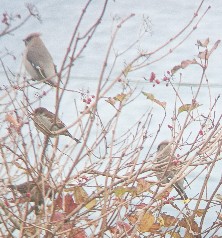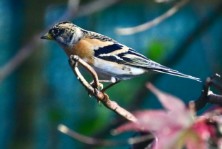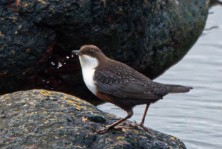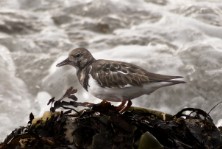October 2023
Bird Sightings



The weather in October was unsettled. October is arguably the busiest birding month, as summer breeders depart, migrants pass through, winter visitors arrive and there is always a strong chance of something unusual. This October did not disappoint.
A particular highlight was a report of three Waxwing on the morning of Tuesday 31 October in a garden in Newton, Lochranza. The observer managed to get this photograph through binoculars. The last Arran report of this irruptive winter visitor was one in Cordon in February 2020.
Other highlights included: a Great Skua flying alongside the Caledonian Isles on 9th (This species was badly affected by avian influenza in 2022), a Nuthatch at the entrance to Cnoc na Dail on 10th (The last Arran report of this species was in Dippen in April 2021) and three further reports of Ring Ouzel. One of these reports was a bird recorded on a camera trap with a night vision option, a reminder that bird migration occurs night and day.
Winter visitors arriving included: one hundred Greylag Geese and twenty Pink-footed Geese in the Shiskine Valley on 8th, a male Goldeneye in Brodick Bay on 9th, thirteen Rook on Cleats shore also on 9th, twenty-four Whooper Swan flying over Lagg on 10th, eight Wigeon at Cosyden on 11th and a pale-bellied Brent Goose at Sandbraes from 15th to 22nd. There were widespread reports of Fieldfare and Redwing, often together. The largest group of Redwing was eight hundred at Lagg on 10th and the largest group of Fieldfare was two hundred at Cnoc na Dail on 24th. There were also twelve reports of Brambling often with the more familiar Chaffinch. The largest group was five in Lagg on 24th. In addition, wintering Blackcap were reported including a male at the Lakin on 25th.
Migration was in full flow in October as birds were moving out of colder northern Europe to milder climes. These included: one hundred Ringed Plover at Drumadoon Point on 2nd, twenty-nine Skylark and thirty Linnet on Cleats shore on 9th, a Greenshank at the black rocks Whiting Bay on 11th, forty Teal in south Carlo on 15th, a Knot on Silver Sands on 21st, seventy Starling also on Silver Sands on 27th, thirty Turnstone in Catacol Bay on 29th and three Dunlin in Porta Leacach on 30th.
There were some “last sightings” of summer visitors also moving south including: a Lesser Black-backed Gull at Sliddery on 14th, a Wheatear on Cleats Shore on 21st, and a Gannet off Pirnmill on 29th. In addition, the only House Martin report was two in Sliddery on 1st. The largest group of Swallow in October was fourteen in Sliddery on 7th and the last report was two by Bridgend Campsite on 30th.
Other interesting records, from a month with over one hundred species reported, included: two Kingfisher in Lamlash on 6th, two Goosander north of Catacol on 10th, fourteen Long-tailed Tit at Porta Buidhe on 11th, forty Great Black-backed Gull at Dougarie on 15th, a Red Kite in Clauchan Glen on 20th, a Yellowhammer in Sliddery on 24th, a Great Northern Diver and a Little Egret in Pirnmill also on 24th, two Common Crossbill in Lagg on 25th, a Magpie by Lamlash Golf Course on 26th, two Shelduck at Thunderguy on 27th and a Dipper at Porta Buidhe on 22nd. Increasingly as winter approaches, Dipper can be seen at the mouth of rivers and burns.
Finally, my thanks to all the “volunteers” who took part in the Eider survey in late September. The total number of birds recorded round Arran was fifty-eight. There was excellent coverage of the Arran coastline. Last year the total was fifty-five. In 2020 it was seventy-five. In 2000, it was considerably more, at over six hundred. The data on the Eider survey contributes to the ongoing research of Chris Waltho who has been monitoring Eider in the Clyde Estuary for almost thirty years. The population trend is down. For the latest report from Chris, visit this website:


